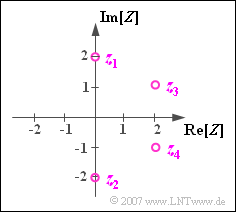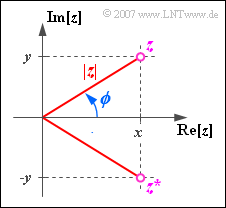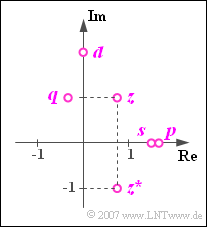Difference between revisions of "Signal Representation/Calculating with Complex Numbers"
| Line 79: | Line 79: | ||
| − | == Representation by | + | == Representation by Amplidute and Phase== |
<br> | <br> | ||
| − | A complex number $z$ can be described not only by the real part $x$ and the imaginary part $y$ but also by its | + | A complex number $z$ can be described not only by the real part $x$ and the imaginary part $y$ but also by its amplitude $|z|$ and the phase $\phi$ . |
[[File:P_ID1246__Sig_T_1_3_S3_neu.png|right|frame|Complex Conjugate of a number]] | [[File:P_ID1246__Sig_T_1_3_S3_neu.png|right|frame|Complex Conjugate of a number]] | ||
| Line 94: | Line 94: | ||
:$$z = |z| \cdot \cos (\phi) + {\rm j} \cdot |z| \cdot \sin (\phi) = |z| \cdot {\rm e}^{{\rm j} \hspace{0.05cm}\cdot \hspace{0.05cm} \phi}.$$ | :$$z = |z| \cdot \cos (\phi) + {\rm j} \cdot |z| \cdot \sin (\phi) = |z| \cdot {\rm e}^{{\rm j} \hspace{0.05cm}\cdot \hspace{0.05cm} \phi}.$$ | ||
| − | + | The '''Euler's theorem''' was used, which is proved below. This states that the complex quantity $ {\rm e}^{{\rm j} \hspace{0.05cm}\cdot \hspace{0.05cm} \phi}$ exhibits the real part $\cos(\phi)$ and the imaginary part $\sin(\phi)$ . | |
| − | + | Further one recognizes from the diagram that for the '''complex conjugates''' of $z = x + {\rm j}\cdot y$ applies:  | |
:$$z^{\star} = x - {\rm j} \cdot y = |z| \cdot {\rm e}^{-{\rm j}\hspace{0.05cm} \cdot \hspace{0.05cm}\phi}.$$ | :$$z^{\star} = x - {\rm j} \cdot y = |z| \cdot {\rm e}^{-{\rm j}\hspace{0.05cm} \cdot \hspace{0.05cm}\phi}.$$ | ||
{{BlaueBox|TEXT= | {{BlaueBox|TEXT= | ||
| − | $\text{ | + | $\text{Proof of the Euler theorem:}$ This is based on the comparison of power series developments. |
| − | * | + | *The series development of the exponential function is: |
:$${\rm e}^{x} = 1 + \frac{x}{1!}+ \frac{x^2}{2!}+ \frac{x^3}{3!} | :$${\rm e}^{x} = 1 + \frac{x}{1!}+ \frac{x^2}{2!}+ \frac{x^3}{3!} | ||
+ \frac{x^4}{4!} +\text{ ...} \hspace{0.15cm}.$$ | + \frac{x^4}{4!} +\text{ ...} \hspace{0.15cm}.$$ | ||
| − | * | + | *With an imaginary argument you can also write: |
:$${\rm e}^{ {\rm j}\hspace{0.03cm} \cdot \hspace{0.03cm}x} = 1 + {\rm j} \cdot \frac{x}{1!}+ {\rm j}^2 \cdot \frac{x^2}{2!}+ {\rm j}^3 \cdot \frac{x^3}{3!} | :$${\rm e}^{ {\rm j}\hspace{0.03cm} \cdot \hspace{0.03cm}x} = 1 + {\rm j} \cdot \frac{x}{1!}+ {\rm j}^2 \cdot \frac{x^2}{2!}+ {\rm j}^3 \cdot \frac{x^3}{3!} | ||
+ {\rm j}^4 \cdot \frac{x^4}{4!} + \text{ ...} \hspace{0.15cm}.$$ | + {\rm j}^4 \cdot \frac{x^4}{4!} + \text{ ...} \hspace{0.15cm}.$$ | ||
| − | * | + | *Considering <math>{\rm j}^{2}=-1, \ \ {\rm j}^{3} = -{\rm j},\ \ {\rm j}^{4} = 1, \ \ {\rm j}^{5} = {\rm j}, \text{ ...} \hspace{0.15cm}</math> and combining the real and the imaginary terms, one obtains |
:$${\rm e}^{ {\rm j}\hspace{0.03cm} \cdot \hspace{0.03cm}x} = A(x) + {\rm j}\cdot B(x).$$ | :$${\rm e}^{ {\rm j}\hspace{0.03cm} \cdot \hspace{0.03cm}x} = A(x) + {\rm j}\cdot B(x).$$ | ||
| − | * | + | * The following applies to both series: |
:$$A(x) = 1 - \frac{x^2}{2!} | :$$A(x) = 1 - \frac{x^2}{2!} | ||
+ \frac{x^4}{4!} - \frac{x^6}{6!}+ | + \frac{x^4}{4!} - \frac{x^6}{6!}+ | ||
| Line 126: | Line 126: | ||
\sin(x).$$ | \sin(x).$$ | ||
| − | * | + | *From this the '''Euler Theorem''' follows directly: |
:$${\rm e}^{ {\rm j}\hspace{0.03cm} \cdot \hspace{0.03cm}x} = \cos (x) + {\rm j} \cdot \sin (x) \hspace{2cm} | :$${\rm e}^{ {\rm j}\hspace{0.03cm} \cdot \hspace{0.03cm}x} = \cos (x) + {\rm j} \cdot \sin (x) \hspace{2cm} | ||
| Line 132: | Line 132: | ||
| − | == | + | ==Calculation Laws for Complex Numbers== |
<br> | <br> | ||
| − | + | The laws of arithmetic for two complex numbers | |
:$$z_1 = x_1 + {\rm j} \cdot y_1 = |z_1| \cdot {\rm e}^{{\rm j}\hspace {0.05cm}\cdot | :$$z_1 = x_1 + {\rm j} \cdot y_1 = |z_1| \cdot {\rm e}^{{\rm j}\hspace {0.05cm}\cdot | ||
| Line 141: | Line 141: | ||
\hspace {0.05cm} \phi_2}$$ | \hspace {0.05cm} \phi_2}$$ | ||
| − | + | are defined in such a way, that for the special case of a vanishing imaginary part, the rules of calculation of real numbers are given. This is called the so called ''principle of permanence''. | |
| − | + | The following rules apply to the basic arithmetic operations: | |
| − | * | + | *The sum of two complex numbers (resp. their difference) is made by adding their real and imaginary parts (resp. subtracting):  |
::<math>z_3 = z_1 + z_2 = (x_1+x_2) + {\rm j}\cdot (y_1 + y_2),</math> | ::<math>z_3 = z_1 + z_2 = (x_1+x_2) + {\rm j}\cdot (y_1 + y_2),</math> | ||
| Line 150: | Line 150: | ||
::<math>z_4 = z_1 - z_2 = (x_1-x_2) + {\rm j}\cdot (y_1 - y_2).</math> | ::<math>z_4 = z_1 - z_2 = (x_1-x_2) + {\rm j}\cdot (y_1 - y_2).</math> | ||
| − | * | + | *The product of two complex numbers can be formed in the real part and imaginary part description by multiplication considering <math>{\rm j}^{2}=-1</math> . However, multiplication is simpler if <math>z_1</math> and <math>z_2</math> are written with absolute value and phase: |
::<math>z_5 = z_1 \cdot z_2 = (x_1\cdot x_2 - y_1\cdot y_2) + {\rm j}\cdot (x_1\cdot y_2 + x_2\cdot y_1),</math> | ::<math>z_5 = z_1 \cdot z_2 = (x_1\cdot x_2 - y_1\cdot y_2) + {\rm j}\cdot (x_1\cdot y_2 + x_2\cdot y_1),</math> | ||
| Line 162: | Line 162: | ||
\Rightarrow \hspace{0.3cm} |z_5| = |z_1| \cdot |z_2| , \hspace{0.3cm}\phi_5 = \phi_1 + \phi_2 .</math> | \Rightarrow \hspace{0.3cm} |z_5| = |z_1| \cdot |z_2| , \hspace{0.3cm}\phi_5 = \phi_1 + \phi_2 .</math> | ||
| − | * | + | *The division is also more manageable in the exponential notation. The two amounts are divided and the phases are subtracted in the exponent: |
::<math>z_6 = \frac{z_1}{z_2} = |z_6| \cdot {\rm e}^{{\rm j} \hspace {0.05cm}\cdot | ::<math>z_6 = \frac{z_1}{z_2} = |z_6| \cdot {\rm e}^{{\rm j} \hspace {0.05cm}\cdot | ||
| Line 169: | Line 169: | ||
\Rightarrow \hspace{0.3cm} |z_6| = \frac{|z_1|}{|z_2|}, \hspace{0.3cm}\phi_6 = \phi_1 - \phi_2 .</math> | \Rightarrow \hspace{0.3cm} |z_6| = \frac{|z_1|}{|z_2|}, \hspace{0.3cm}\phi_6 = \phi_1 - \phi_2 .</math> | ||
| − | [[File:P_ID825_Sig_T_1_3_S4_neu.png|right|frame| | + | [[File:P_ID825_Sig_T_1_3_S4_neu.png|right|frame|Sum, difference, product & quotient of complex numbers]] |
{{GraueBox|TEXT= | {{GraueBox|TEXT= | ||
$\text{Beispiel 2:}$ | $\text{Beispiel 2:}$ | ||
| − | In | + | In the graphic are shown as points within the complex plane: |
| − | * | + | *the complex number <math>z=0.75 + {\rm j} = 1.25 \cdot {\rm e}^{\hspace{0.03cm}{\rm j}\hspace{0.03cm} \cdot \hspace{0.05cm}53.1^{\circ} }</math>, |
| − | * | + | *its complex conjugate <math>z^{\ast} = 0.75 - {\rm j} = 1.25 \cdot {\rm e}^{ - {\rm j} \hspace{0.03cm}\cdot \hspace{0.03cm}53.1^{\circ} }</math>, |
| − | * | + | *the sum <math>s=z+z^{\ast}=1.5</math> (purely real), |
| − | * | + | *the difference <math>d=z-z^{\ast}=2 \cdot {\rm j}</math> (purely imaginary), |
| − | * | + | *the product <math>p=z \cdot z^{\ast} = 1.25^{2} \approx 1.5625</math> (purely real), |
| − | * | + | *the division <math>q= {z}/{z^{\ast} }={\rm e}^{\hspace{0.05cm} {\rm j} \hspace{0.03cm}\cdot \hspace{0.03cm}106.2^{\circ} }</math> with amplitude $1$ and the double phase angle of $z$.}} |
| − | + | The topic of this chapter is covered in detail in the learning video [[Rechnen_mit_komplexen_Zahlen_(Lernvideo)|Rechnen mit komplexen Zahlen]] ,which is in german language. | |
| − | == | + | ==Exercises for the chapter== |
<br> | <br> | ||
| − | [[Aufgaben:1.3 Rechnen mit komplexen Zahlen| | + | [[Aufgaben:1.3 Rechnen mit komplexen Zahlen|Exercise 1.3: Calculating With Complex Numbers]] |
| − | [[Aufgaben:1.3Z_Nochmals komplexe Zahlen| | + | [[Aufgaben:1.3Z_Nochmals komplexe Zahlen|Exercise 1.3Z: Complex Numbers Again]] |
{{Display}} | {{Display}} | ||
Revision as of 17:07, 18 September 2020
Contents
The Set of Real Numbers
In the following chapters of this book, complex quantities always play an important role. Although calculating with complex numbers is already treated and practiced in school mathematics, our experience has shown that even students of natural sciences and technical subjects have problems with it. Perhaps these difficulties are also related to the fact that "complex" is often used as a synonym for "complicated" in everyday life, while "real" stands for "reliable, honest and truthful" according to the Duden dictionary.
Therefore, the calculation rules for complex numbers are briefly summarized here at the end of this first basic chapter.
First there are some remarks about real quantities of numbers, for which in the strict mathematical sense the term "number field" would be more correct. These include:
$\text{Definitionen:}$
- Natural Numbers $\mathbb{N} = \{1, 2, 3, \text{...}\hspace{0.05cm} \}$. Using these numbers, for $n, \ k \in \mathbb{N}$ the arithmetic operations „addition” $(m = n +k)$, „multiplication” $(m = n \cdot k)$ and „power formation” $(m = n^k)$ are possible. The respective result of a calculation is again a natural number: $m \in \mathbb{N}$.
- Total Numbers $\mathbb{Z} = \{\text{...}\hspace{0.05cm} , -3, -2, -1, \ 0, +1, +2, +3, \text{...}\hspace{0.05cm}\}$. This set of numbers is an extension of the natural numbers $\mathbb{N}$. The introduction of the set $\mathbb{Z}$ was necessary to capture the result set of a subtraction $(m = n -k)$ for example $5 - 7 = - 2$.
- Rational Numbers $\mathbb{Q} = \{z/n\}$ with $z \in \mathbb{Z}$ and $n \in \mathbb{N}$. With this set of numbers, also known as fractions, there is a defined result for each division. If you write a rational number in decimal notation, only zeros appear after a certain decimal place $($Example: $-2/5 = -0.400\text{...}\hspace{0.05cm})$ or periodicities $($Example: $2/7 = 0.285714285\text{...}\hspace{0.05cm})$. Since $n = 1$ is allowed, the integers are a subset of the rational numbers: $\mathbb{Z} \subset \mathbb{Q}$.
- Irrational Numbers $\mathbb{I} \neq {z/n}$ mit $z \in \mathbb{Z}$, $n \in \mathbb{N}$. Although there are infinite rational numbers, there are still infinite numbers which cannot be represented as a fraction. Examples are the number $\pi = 3.141592654\text{...}\hspace{0.05cm}$ (where there are no periods even with more decimal places) or the result of the equation $a^{2}=2 \,\,\Rightarrow \;\;a=\pm \sqrt{2}=\pm1.414213562\text{...}\hspace{0.05cm}$. This result is also irrational, which has already been proved by Euclid in antiquity.
- Real Numbers $\mathbb{R} = \mathbb{Q} \cup \mathbb{I}$ as the sum of all rational and irrational numbers.
- These can be ordered according to their numerical values and can be drawn on the so called number line as shown in the adjacent graph.
Imaginary and Complex Numbers
With the introduction of the irrational numbers the solution of the equation $a^2-2=0$ was possible, but not the solution of the equation $a^2+1=0$.
The mathematician Leonhard Euler solved this problem by extending the set of real numbers by the imaginary numbers . He defined the imaginary unit as follows:
- $${\rm j}=\sqrt{-1} \ \Rightarrow \ {\rm j}^{2}=-1.$$
It should be noted that Euler called this quantity „$\rm i$” and this is still common in mathematics today. In electrical engineering, on the other hand, the designation „$\rm j$” has become generally accepted since „$\rm i$” is already occupied by the time-dependent current.
$\text{Definition:}$ The complex number $z$ is generally the sum of a real number $x$ and an imaginary number ${\rm j} \cdot y$:
- $$z=x+{\rm j}\cdot y.$$
$x$ and $y$ are derived from the quantity $\mathbb{R}$ from the real numbers. The set of all possible complex numbers is called the body $\mathbb{C}$ of the complex numbers.
The number line of real numbers now becomes the complex plane, which is spanned by two number strings twisted by $90^\circ$ for real– and imaginary part.
$\text{Beispiel 1:}$ The complex number $z_1 = 2 \cdot {\rm j}$ is one of two possible solutions of the equation $z^2+4=0$. The other solution is $z_2 = -2 \cdot {\rm j}$.
In contrast $z_3 = 2 + {\rm j}$ and $z_4 = 2 -{\rm j}$ give the two solutions to the following equation:
- $$(z-2- {\rm j})(z-2+ {\rm j}) = 0 \; \ \Rightarrow \;\ z^{2}-4 \cdot z+5=0.$$
$z_4 = z_3^\ast$ is also called the Complex Conjugate of $z_3$.
- The sum $z_3 + z_4$ is real:
- $$z_3 + z_4 = 2 \cdot {\rm Re}[z_3]=2 \cdot {\rm Re}[z_4].$$
- The difference $z_3 - z_4$ is purely imaginary:
- $$z_3 - z_4 = {\rm j} \cdot \big [2 \cdot {\rm Im}[z_3] \big ] ={\rm j} \cdot \big [-2 \cdot {\rm Im}[z_4] \big ].$$
Note: In the literature, complex quantities are often marked by underlining. This is not used in the $\rm LNTwww$–books.
Representation by Amplidute and Phase
A complex number $z$ can be described not only by the real part $x$ and the imaginary part $y$ but also by its amplitude $|z|$ and the phase $\phi$ .
The following conversions apply:
- $$\left | z \right | = \sqrt{x^{2}+y^{2}}, \hspace{0.6cm}\phi = \arctan ({y}/{x}),$$
- $$x = |z| \cdot \cos(\phi), \hspace{0.6cm} y = |z| \cdot \sin(\phi ).$$
Thus the complex size $z$ can also be displayed in the following form
- $$z = |z| \cdot \cos (\phi) + {\rm j} \cdot |z| \cdot \sin (\phi) = |z| \cdot {\rm e}^{{\rm j} \hspace{0.05cm}\cdot \hspace{0.05cm} \phi}.$$
The Euler's theorem was used, which is proved below. This states that the complex quantity $ {\rm e}^{{\rm j} \hspace{0.05cm}\cdot \hspace{0.05cm} \phi}$ exhibits the real part $\cos(\phi)$ and the imaginary part $\sin(\phi)$ .
Further one recognizes from the diagram that for the complex conjugates of $z = x + {\rm j}\cdot y$ applies: 
- $$z^{\star} = x - {\rm j} \cdot y = |z| \cdot {\rm e}^{-{\rm j}\hspace{0.05cm} \cdot \hspace{0.05cm}\phi}.$$
$\text{Proof of the Euler theorem:}$ This is based on the comparison of power series developments.
- The series development of the exponential function is:
- $${\rm e}^{x} = 1 + \frac{x}{1!}+ \frac{x^2}{2!}+ \frac{x^3}{3!} + \frac{x^4}{4!} +\text{ ...} \hspace{0.15cm}.$$
- With an imaginary argument you can also write:
- $${\rm e}^{ {\rm j}\hspace{0.03cm} \cdot \hspace{0.03cm}x} = 1 + {\rm j} \cdot \frac{x}{1!}+ {\rm j}^2 \cdot \frac{x^2}{2!}+ {\rm j}^3 \cdot \frac{x^3}{3!} + {\rm j}^4 \cdot \frac{x^4}{4!} + \text{ ...} \hspace{0.15cm}.$$
- Considering \({\rm j}^{2}=-1, \ \ {\rm j}^{3} = -{\rm j},\ \ {\rm j}^{4} = 1, \ \ {\rm j}^{5} = {\rm j}, \text{ ...} \hspace{0.15cm}\) and combining the real and the imaginary terms, one obtains
- $${\rm e}^{ {\rm j}\hspace{0.03cm} \cdot \hspace{0.03cm}x} = A(x) + {\rm j}\cdot B(x).$$
- The following applies to both series:
- $$A(x) = 1 - \frac{x^2}{2!} + \frac{x^4}{4!} - \frac{x^6}{6!}+ \text{ ...} \hspace{0.1cm}= \cos(x),\hspace{0.5cm} B(x) = \frac{x}{1!}- \frac{x^3}{3!} + \frac{x^5}{5!} - \frac{x^7}{7!}+ \text{ ...}= \sin(x).$$
- From this the Euler Theorem follows directly:
- $${\rm e}^{ {\rm j}\hspace{0.03cm} \cdot \hspace{0.03cm}x} = \cos (x) + {\rm j} \cdot \sin (x) \hspace{2cm} \rm q.e.d.$$
Calculation Laws for Complex Numbers
The laws of arithmetic for two complex numbers
- $$z_1 = x_1 + {\rm j} \cdot y_1 = |z_1| \cdot {\rm e}^{{\rm j}\hspace {0.05cm}\cdot \hspace {0.05cm} \phi_1}, \hspace{0.5cm} z_2 = x_2 + {\rm j} \cdot y_2 = |z_2| \cdot {\rm e}^{{\rm j} \hspace {0.05cm}\cdot \hspace {0.05cm} \phi_2}$$
are defined in such a way, that for the special case of a vanishing imaginary part, the rules of calculation of real numbers are given. This is called the so called principle of permanence.
The following rules apply to the basic arithmetic operations:
- The sum of two complex numbers (resp. their difference) is made by adding their real and imaginary parts (resp. subtracting): 
- \[z_3 = z_1 + z_2 = (x_1+x_2) + {\rm j}\cdot (y_1 + y_2),\]
- \[z_4 = z_1 - z_2 = (x_1-x_2) + {\rm j}\cdot (y_1 - y_2).\]
- The product of two complex numbers can be formed in the real part and imaginary part description by multiplication considering \({\rm j}^{2}=-1\) . However, multiplication is simpler if \(z_1\) and \(z_2\) are written with absolute value and phase:
- \[z_5 = z_1 \cdot z_2 = (x_1\cdot x_2 - y_1\cdot y_2) + {\rm j}\cdot (x_1\cdot y_2 + x_2\cdot y_1),\]
- \[z_5 = |z_1| \cdot {\rm e}^{{\rm j} \hspace {0.05cm}\cdot \hspace {0.05cm} \phi_1} \cdot |z_2| \cdot {\rm e}^{{\rm j}\hspace {0.05cm}\cdot \hspace {0.05cm} \phi_2}= |z_5| \cdot {\rm e}^{{\rm j} \hspace {0.05cm}\cdot \hspace {0.05cm} \phi_5} \hspace{0.3cm} \Rightarrow \hspace{0.3cm} |z_5| = |z_1| \cdot |z_2| , \hspace{0.3cm}\phi_5 = \phi_1 + \phi_2 .\]
- The division is also more manageable in the exponential notation. The two amounts are divided and the phases are subtracted in the exponent:
- \[z_6 = \frac{z_1}{z_2} = |z_6| \cdot {\rm e}^{{\rm j} \hspace {0.05cm}\cdot \hspace {0.05cm} \phi_6} \hspace{0.3cm} \Rightarrow \hspace{0.3cm} |z_6| = \frac{|z_1|}{|z_2|}, \hspace{0.3cm}\phi_6 = \phi_1 - \phi_2 .\]
$\text{Beispiel 2:}$ In the graphic are shown as points within the complex plane:
- the complex number \(z=0.75 + {\rm j} = 1.25 \cdot {\rm e}^{\hspace{0.03cm}{\rm j}\hspace{0.03cm} \cdot \hspace{0.05cm}53.1^{\circ} }\),
- its complex conjugate \(z^{\ast} = 0.75 - {\rm j} = 1.25 \cdot {\rm e}^{ - {\rm j} \hspace{0.03cm}\cdot \hspace{0.03cm}53.1^{\circ} }\),
- the sum \(s=z+z^{\ast}=1.5\) (purely real),
- the difference \(d=z-z^{\ast}=2 \cdot {\rm j}\) (purely imaginary),
- the product \(p=z \cdot z^{\ast} = 1.25^{2} \approx 1.5625\) (purely real),
- the division \(q= {z}/{z^{\ast} }={\rm e}^{\hspace{0.05cm} {\rm j} \hspace{0.03cm}\cdot \hspace{0.03cm}106.2^{\circ} }\) with amplitude $1$ and the double phase angle of $z$.
The topic of this chapter is covered in detail in the learning video Rechnen mit komplexen Zahlen ,which is in german language.
Exercises for the chapter
Exercise 1.3: Calculating With Complex Numbers
Exercise 1.3Z: Complex Numbers Again



